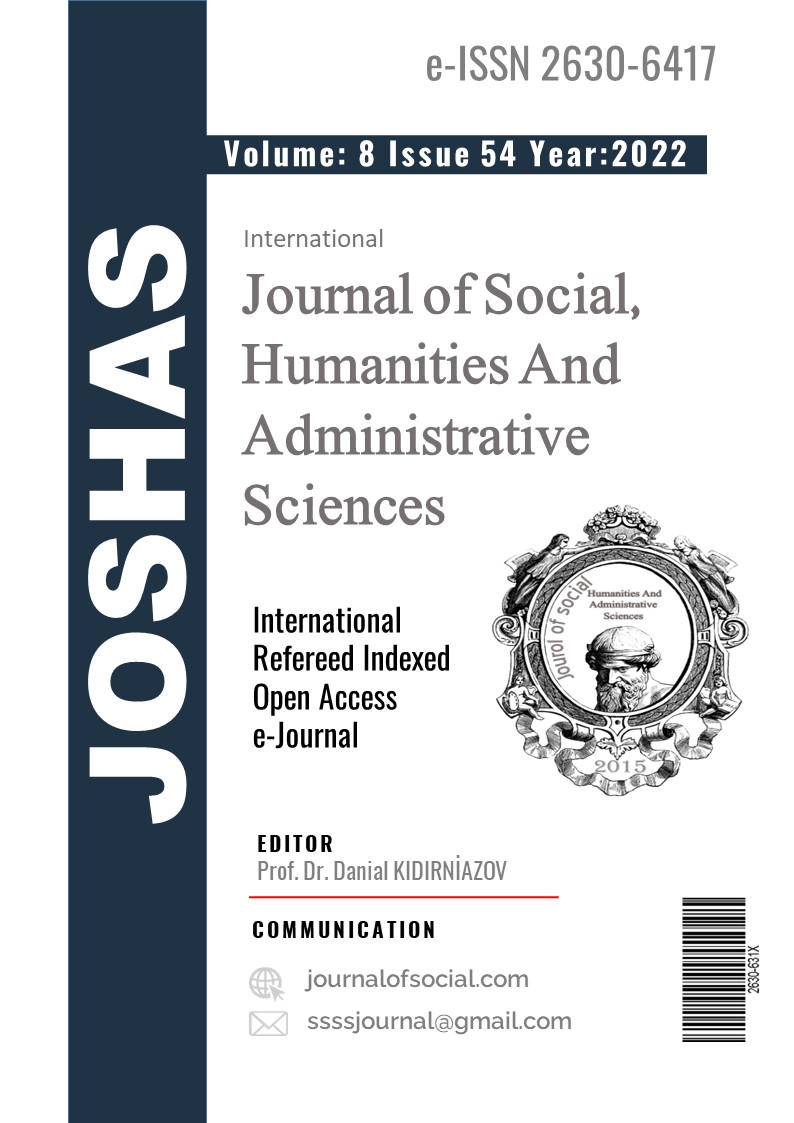Author :
Abstract
Türkçe söz diziminin hakkında kabul birliği sağlanamamış konularından biri de birleşik isim grubudur. Genellikle farklı bakış açılarıyla ele alınan söz konusu kelime grubunun başta varlığı olmak üzere terim adı, tanımı, yapısı, kuruluşu ve özellikleri ile ilgili bugüne kadar bir kabul sağlanamamıştır. Bu kelime grubunun dilbilgisi kaynaklarında farklı şekillerde ele alınması, “hanımeli, biçerdöver, gecekondu, günebakan” gibi yapılardan oluşan “birleşik isim grubu” ile “Yaşar Kemal, Mehmet Akif Ersoy, Mustafa Kutlu” gibi birden fazla kelimeden oluşan kişi adları ya da kişi ad ve soyadlarından oluşan “kişi ismi grubu”nun karışmasına sebep olmuştur. Yapı ve kuruluş bakımından farklı olan bu iki kelime grubunun başta terim adı olmak üzere tanımı, yapısı ve kuruluş özelikleri ile sınırlarının belirlenmesini zorlaştıran söz konusu durum, zamanla içinden çıkılmaz bir hal alarak sadece birleşik isim grubu ile kişi ismi grubunun değil, aynı zamanda kelime grupları ve sözdiziminin dolayısıyla da Türkçenin öğrenilmesi ve öğretilmesine zarar verecek boyutlara ulaşmıştır.
Bu çalışmada, Türkçe’nin tarihî gelişim ve değişim süreci ile söz dizimi özellikleri esas alınarak birleşik isim grubu bütün yönleriyle incelenmiştir. Öncelikle birleşik isim grubunun dilbilgisi kaynaklarında farklı ele alınış biçimleri ile bu konuda ortaya atılan benzer ve farklı görüşler eleştirel bir bakış açısıyla ele alınarak birleşik isim grubu ile ilgili sorunlara dikkat çekilmiştir. Daha sonra bu kelime grubu; terim adı, tanımı, yapısı, kuruluşu, yazılış şekli, unsurları, cümle ve kelime grupları içerisindeki yeri ile cümledeki görevleri bakımından ele alınarak özellikleri belirlenmiş ve bu özellikler Türk edebiyatının seçkin eserlerinden alınan cümlelerle örneklendirilmiştir. Böylece birleşik isim grubunun tanımı, terim adı, sınırları ve özelliklerinin doğru belirlenmesine, bu kelime grubuyla ilgili eskiden beri tekrar edilegelen doğruluğu tartışmalı bilgilerin düzeltilmesine, dolayısıyla söz konusu kelime grubunun doğru öğrenilmesi ve öğretilmesine katkıda bulunulmaya çalışılmıştır.
Keywords
Abstract
One of the subjects of Turkish syntax on which there is no consensus is the issue of the compound noun group. Until today, no consensus has been reached regarding the term name, definition, structure, organization and features, and especially the existence of the said word group, which is generally handled from different perspectives. Handling of this word group in different ways in grammatical sources has caused confusion in the "compound noun group" consisting of structures such as " hanımeli, biçerdöver, gecekondu, günebakan" and the “personal name group (Anthroponomy)" consisting of more than one personal name or personal name and surname such as "Yaşar Kemal, Mehmet Akif Ersoy, Mustafa Kutlu". This situation, which makes it difficult to set boundaries of the term name, definition, and structures of these two word groups, which are different in terms of structure, has turned into an inextricable issue over time, causing disadvantages not only for the compound noun group and the personal name group, but also for the learning and teaching of word groups and syntax and therefore of Turkish.
In this study, the compound noun group is examined in all its aspects based on the historical development and change process of Turkish and its syntax features. First of all, the different ways in which the compound noun group is handled in the grammatical sources and the similar and different views on this subject were handled with a critical point of view, and attention was drawn to the problems related to the compound noun group. Then, this word group was handled in terms of term name, definition, structure, formation, writing style, elements, the order in sentences and word groups, and its functions in the sentence were determined and these features were exemplified with sentences taken from distinguished works of Turkish literature. Thus, the researcher aimed to contribute to the correct definition of the compound noun group, the definition of the term name, its boundaries and features, to the correction of the controversial information about this word group that has been repeated for a long time, and thus to the correct learning and teaching of the said word group.
Keywords
- 1. AÇIKGÖZ, Halil - Muhammet YELTEN (2005) Kelime Grupları, Doğu Kütüphanesi, İstanbul.
- 2. AKTAN, Bilâl (2016) Türkiye Türkçesinin Söz Dizimi, Gazi Kitabevi, Ankara.
- 3. BANGUOĞLU Tahsin (2000) Türkçenin Grameri, Türk Dil Kurumu Yayınları, Ankara.
- 4. BÖLER, Tuncay (2019) Türkiye Türkçesi Söz Dizimi, Kesit yayınları, İstanbul.
- 5. BULAK, Şahap (2017)"Türkçe Öğretiminde Terim Sorunu" Uluslararası Türk Dili ve Edebiyatı Bilgi Şöleni, Atatürk Üniversitesi, 12-14 Mayıs 2017, Erzurum.
- 6. DELİCE, H. İbrahim (2012) Türkçe Sözdizimi, Kitabevi Yayınevi, İstanbul.
- 7. DEMİR, Celal (2009) “Türkçe Dil Bilgisinde Terminoloji Sorunu”, Türk Dili Araştırmaları Yıllığı - Belleten, 54 (2006/1) , 81-100.
- 8. DİZDAROĞLU, Hikmet (1976) Tümce Bilgisi, Türk Dil Kurumu Yayınları, Ankara.
- 9. EKER, Süer (2005) Çağdaş Türk Dili, Grafiker Yayınları, Ankara.
- 10. ERGİN, Muharrem (2006) Türk Dil Bilgisi, Bayrak Yayınları, İstanbul.
- 11. GENCAN, Tahir Nejat; (1979) Dilbilgisi, Türk Dil Kurumu Yayınları, Ankara.
- 12. HATİBOĞLU, Vecihe (1972) Dilbilgisi Terimleri Sözlüğü, Türk Dil Kurumu Yayınları, Ankara.
- 13. HATİBOĞLU, Vecihe (1982) Türkçenin Sözdizimi, Dil ve Tarih-Coğrafya Fakültesi Basımevi, Ankara.
- 14. KARAAĞAÇ, Günay (2011) Türkçenin Sözdizimi, Kesit Yayınları, İstanbul.
- 15. KARAHAN, Leyla (1999) Türkçede Söz Dizimi –Cümle Tahlilleri, Akçağ Yayınları, Ankara.
- 16. KORKMAZ, Zeynep (1992) Gramer Terimleri Sözlüğü, Türk Dil Kurumu Yayınları, Ankara.
- 17. ÖZKAN- Mustafa-Veysi SEVİNÇLİ (2011) Türkiye Türkçesi Söz Dizimi, Akademik Kitaplar Yayınevi, 3. Baskı, İstanbul.
- 18. ÖZKAN, Abdurrahman- Mustafa TOKER- Ufuk Deniz AŞÇI (2016) Türkiye Türkçesi Söz Dizimi, Palet Yayınları, Konya.
- 19. ÖZKAN, Abdurrahman (2018) “Bir Söz Dizimi Terimi: Özel İsim Grubu”, SUTAD, Bahar 2018; S.43 s.1-11.
- 20. ÖZMEN, Mehmet (2013) Türkçenin Sözdizimi, Karahan Kitabevi, Adana.
- 21. TOPALOĞLU, Ahmet (1994) Dil Bilgisi Terimleri Sözlüğü, Ötüken Yayınları, Birinci Basım, İstanbul.
- 22. ZÜLFİKAR, Hamza (1991) Terim Sorunları ve Terim Yapma Yolları, Türk Dil Kurumu Yayınları, Ankara.





